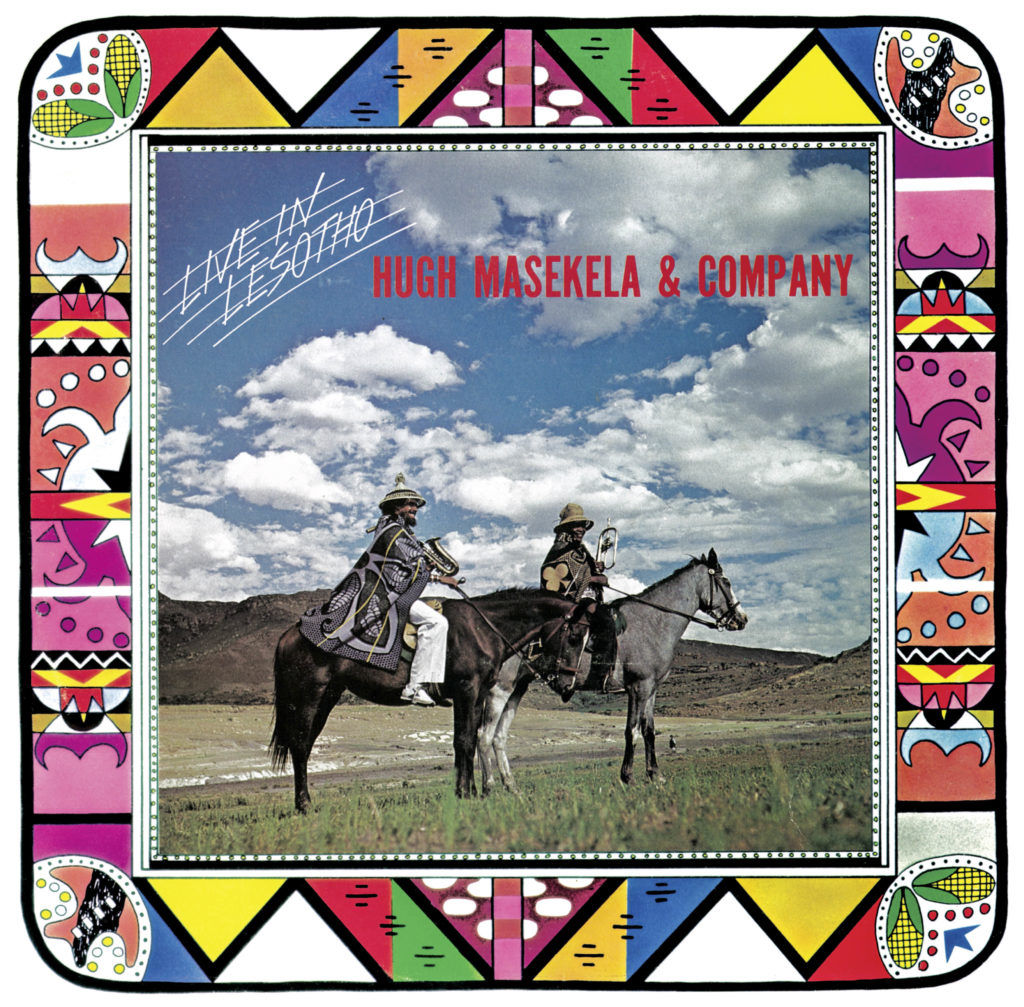Close to home: Legendary singer Miriam Makeba with fellow musician Hugh Masekela in Lesotho in 1980. (Gallo Images/Sunday Times and Gallo Images/Avusa)
“[Hugh Masekela and Company’s] Live in Lesotho is, once again, Hugh and Miriam [Makeba] standing up in defiance,” says nephew Mabusha Masekela of the historic pair of December 28 1980 shows, the second of which has been reissued on vinyl by Matsuli Music. “It could have been a dangerous thing. These cats [the apartheid government] didn’t hesitate to go across the border and kill people. It was a thing of theirs.”
 (Matsuli Music)
(Matsuli Music)
Initially released by Down South Records in 1981 (an entity formed by Hugh Masekela, musician and producer David Marks and businessman Blowie Moloi), Live in Lesotho captures the night-time Hugh Masekela show in a Lesotho hotel, after the blockbuster stadium event in front of more than 70000 fans, many of them from South Africa.
“Musically, the band was on fire and we had phenomenally awesome creative moments on both shows,” says horn player René McLean. “But as I recollect, the tech people used the first show [at the stadium] as a rehearsal to get all the kinks out and the sound right. They wanted everything to be technologically perfect sound wise, which can be challenging when it’s a live performance.”
The initial print runs amounted to fewer than 700 copies. “Marks recalls that when he took Live in Lesotho to shops in South Africa,” writes Atiyyah Khan in the vinyl liner notes, “none of them seemed interested in stocking the album. At a time when other Masekela albums were selling in their thousands, it was puzzling why Live in Lesotho was somehow not so easily available in South Africa. It was never released internationally.”
It was Moloi, a businessman and music lover, who hustled up the capital to organise a series of “Welcome Home” concerts in Botswana, Swaziland and Lesotho, starring Masekela and Makeba. In the end, after political pressure and propaganda campaigns by the apartheid regime, only the Lesotho shows would materialise.
“Knowing where Lesotho is you can imagine the kind of vibes,” says Mabusha Masekela. “People who would have gone to the other two concerts descended on Lesotho.”
Although the business of the day was music and the portent of revolution it embodied, the moment lived up to its billing as a “homecoming”. Apart from Zaire 74, a sprawling, three-day live event linked to the Rumble in the Jungle (which Hugh Masekela had conceived with business partner Stuart Levine), Makeba and Masekela had not played anywhere near Southern Africa for two decades. “We were all excited,” says actress, dancer and singer Thembi Mtshali-Jones. She had been in New York since 1976, when she performed there in the Ipi Ntombi ensemble. “Number one, it was to see our friends, families and our children after such a long time. I was in a sort of self-imposed exile, but I was not in a position to go back [to South Africa].
“There was lots of crying and joy. It was really a mixed bag of feelings. I hadn’t seen my daughter for four years and she came there with her granny. I remember clearly; it was in the middle of a song we were rehearsing. I saw them and ran offstage and everything stopped once the band realised what was happening,” Mtshali-Jones says.
The exhilaration of the shows, however, was prefaced with trepidation. “We had travelled via Kenya from New York,” she remembers. “Miriam stayed in Swaziland with her niece before flying to Lesotho. I remember her saying, ‘God, I hope they don’t shoot the flight down.’ It was a historic landing in Lesotho.”
According to Mabusha Masekela, who boasts encyclopaedic knowledge of Uncle Hughie’s catalogue, Live in Lesotho finds the musician in a sort of musical and existential interregnum, having gone back to the United States, after a short sojourn to Liberia, which had just suffered a coup. The concerts in Lesotho become a pivot homeward, musically and thematically.
In the repertoire, aside from the rollicking funk take of Orlando Julius Ekemode’s Ashiko, Masekela turns to South Africa, if one looks at the compositions and their writers. As an entire set, the selections of Hotep Idris Galeta, Caiphus Semenya and Makeba invoke the sense of community that kept exiles alive, while also speaking to Hugh’s travels across the free continent. Sonically too, the set traverses a range of emotion, capturing the torment of a life lived on the run converging with the steely resolution to be free. “His catalogue from that point on — all he does is South African music with a little bit of R&B and Motown thrown in,” says Mabusha. “Hope, Beating Around The Bush, Up Township, Tomorrow, Waiting For the Rain, Techno-Bush, they are all heavy in South African idiom, musically speaking … The following album, Home, while recorded mostly in New York, if you check some of the songs in there, one is Johannesburg, another is Cape Town, Soweto and Durban.
In 1985, while in Botswana, the apartheid regime assassinated 16 people, including artist and activist Thami Mnyele and Masekela’s friend George Phahle. Shaken, Masekela moved to England, writes Khan, recording the commercially successful Tomorrow, which spawned the hit Bring Him Back Home. “In what they [Hugh and Miriam] were doing, there are parallels to Bob Marley,” says Mabusha. “Bob is a revolutionary figure, but Hugh and Miriam paved the way to that kind of musical behaviour where music becomes a vehicle to freedom; where it’s not explicit like Get Up Stand Up, but playing the music of home in defiance of current trends and whatever Americanisms might creep into the music. That, in and of itself, is an act of defiance. To play it a few kilometres from the border says something of the power of music that politicians and, these days journalists, kind of fear.”
Hugh Masekela and Company Live in Lesotho is out on Matsuli Music